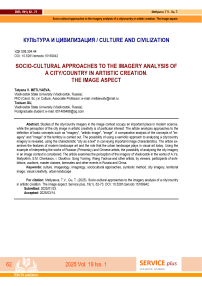Socio-Cultural Approaches to the Imagery Analysis of a City/Country in Artistic Creation. The Image Aspect
Автор: Metlyaeva T.V., Gu T.
Журнал: Сервис plus @servis-plus
Рубрика: Культура и цивилизация
Статья в выпуске: 1 т.19, 2025 года.
Бесплатный доступ
Studies of the city/country imagery in the image context occupy an important place in modern science, while the perception of the city image in artistic creativity is of particular interest. The article analyzes approaches to the definition of basic concepts such as "imagery", "artistic image", "image". A comparative analysis of the concepts of "imagery" and "image" of the territory is carried out. The possibility of using a semiotic approach to analyzing a city/country imagery is revealed, using the characteristic "city as a text" in conveying important image characteristics. The article examines the features of modern landscape art and the role that the urban landscape plays in visual art today. Using the example of interpreting the works of Russian (Primorsky) and Chinese artists, the possibility of analyzing the city imagery in an image context is considered. The article examines the perception of the imagery of Vladivostok in the works of A.Ya. Matyukhin, S.M. Cherkasov, I. Obukhov, Song Yuming, Wang Yaohua and other artists, by viewers, participants of exhibitions, auctions, master classes, biennales and other events in Russia and China.
Culture, imageology, imagology, sociocultural approaches, symbolic method, city imagery, territorial image, visual creativity, urban landscape
Короткий адрес: https://sciup.org/140309207
IDR: 140309207 | УДК: 008.304.44 | DOI: 10.5281/zenodo.15169942
Текст научной статьи Socio-Cultural Approaches to the Imagery Analysis of a City/Country in Artistic Creation. The Image Aspect
At the present stage of society's development, there is an increasing need to study the perception of images of different countries and national identities that are regional "neighbors" or are in close economic, political and socio-cultural relations. This area of scientific research is of interest today not only to specialists in the field of territorial marketing, geoculture, image makers, but also becomes relevant for sociologists, cultural scientists, art historians, and other specialists.
The relevance of the research topic is dictated by the fact that the techniques of analyzing the image of various cities, countries, and cultures in the context of their image component are being actively explored in modern science.
Of particular relevance is the opportunity through the means of art to understand peculiarities of perception of regions and to establish the foundations of artistic visual language as a form of culture representing images of individual territories and countries, allowing us to understand the value meanings embedded by artists in the image, as well as to identify the attitude of viewers to these objects, - and therefore their image.
This topic is also relevant because in modern culture the image of a city, region, country or other territory is important not only when choosing a place for tourism, work, but also cultural interaction between people. Along with this, in the modern world, it is art that is one of the catalysts in the formation of the cultural code of a certain ethnic group, the place of its existence as the basis of artistic creativity is a sensual, emotional perception of what the artist embodies in his work.
The analysis of the image of a city / country through works of art is dictated by the need to deeply comprehend the influence of the means of artistic creation on the perception of a modern person not only of this work itself, but also through it the comprehension of culture as a whole, the education of its aesthetic and moral foundations.
The subject of the research is sociocultural approaches to image analysis of a city/country by means of art in an image context.
The object of the study is the image of the city.
The purpose of the scientific work is to explore sociocultural approaches to image analysis cities/ countries in artistic creation (using the examples of Russian (Primorye) artists' and Chinese artists' works.
The objectives of this research work:
-
1. To analyze the theoretical approaches to the determining the main directions of cultural research in the analysis of the image of a city/country.
-
2. To consider the possibility of using cultural approaches and methods in studying the image of a city/country using the works of Russian (Primorye) and Chinese artists as the examples.
Research methodology
The study was based on the approach of Cultural Studies and the following methods: structural-functional method, in order to identify the proportion between the concepts of “image” and “image”, “artistic image”, analysis of domestic and foreign scientific works, literature and scientific research sites. The semiotic method was used to analyze the paintings of Russian (Primorye) and Chinese artists dedicated to the image of the city of Vladivostok.
The Main part
At the beginning of this study, it is necessary to emphasize that imagology is a fairly young field, especially in cultural studies, little studied. Although in modern science there is enough sociological, political, economic research related to the issue of the image of politicians and political parties, the image of organizations, goods and services, as well as territorial image, however, there is not enough research devoted to the analysis of the image of a city/country using the means of fine art. There are only individual articles and small publications in periodicals. That is why the study is devoted to this area. The concept of “image”, borrowed from English, began to be actively used in Russia only in the late 80s of the last century, thanks to the transition to market relations and the emergence of such a direction as marketing, associated with the promotion of enterprises, their goods and services and having nothing in common with cultural studies. But it seems only at first glance, because the concept of "image" as something complex literally means "image" as a look in English, but IT IS the key one in cultural studies.
That is why, at the beginning of the study, it is necessary to focus on defining the basic concepts that are significant for this study, such as: “image”, “artistic image”, “image” and “symbol”.
According to the conducted etymological studies, it was revealed that the term "image" can be defined as a picture of an object that arose in a person's mind and reflects objects and phenomena of the surrounding reality. The authors Qin Qiwen and Zhou Yongkang in the book "Introduction to Imagology" consider the concept of "image" in three directions: firstly, as the appearance and shape of a person and objects, and secondly, it is a substance that can act on human senses, generating impressions, ideas, thoughts and emotional activity, and finally, it is the unity of the concrete and the abstract, as well as the material and the spiritual [15, p. 4.].
However, in English there are several meanings corresponding to the concept of "image", this is the literal translation of "image", as well as "figure", "form", "identity". According to Lian Xiaoming, research in the field of the country's image, which originated in Europe in the 1990s, has now turned into a mature system. And, although these studies are mainly based on the study and discussion of the image aspect, they cover a complex range of factors such as time, psychological space, ways of visions, attitudes, cognitive schemas, the collective unconscious, ideology, utopia, the history of ideas, hierarchical relationships, thinking, language, fiction, projection and even the theory of imagination, etc. And in this complex interaction we find the same complex structural basis of the image when we consider the image of the city/country [20].
The scientific field "imagology" originated in France in the 50s, but greater interest in it began to develop in China in the works of Meng Hua, the subject of imagology studies were images of "other"(some else), "other" (as something different), "foreign" countries, cultures, nationalities. In the context of imagology, the following dimensions of the "Image" can be distinguished: internal and external, general and local, static and dynamic, real and false, material and spiritual. The complexity of these factors and the setting of these dimensions in imagology provides a useful analytical tool for understanding the image of the state.
The concept of "image" is a complex, polysemantic term that includes a large volume of meanings in the range from objects of the material world to visual objects. An image, from the point of view of philosophy, is the result of reflecting an object in a person's mind. According to Plato, an image is an external and internal way of being an object, whereas Aristotle argued that the image is inside a person, and the source of this image is the material world, that is, the image is a kind of intermediary between the rational and sensual principles of man. And the source of creating an image is imagination, as a movement arising from a sensation in action. The main function of the image is to reflect something more "meaningful" that is beyond the limits of human subjectivity. Therefore, the image is considered as a creative principle that allows a person to know the reality around him [16, p. 446].
Ancient philosophers considered the image, on the one hand, as the specific external material appearance of an object, and on the other hand, the internal, ideological component of the essence of this object or phenomenon. According to Aristotle, Images are mental intermediaries between feelings and mind, a bridge between the inner world of consciousness and the outer world of material reality” [1, p. 1087]. Along with this, in the interpretation of G.V.F. Hegel’s image is the act and result of the creative transformation of reality. That is why in Hegel’s aesthetics the image is viewed through the prism of artistry; he believes that “art depicts the truly universal, or the idea in the form of the sensory existence of the image" [10, P. 412].
An artistic image is a method and form of transformation and mastering of reality. A number of authors such as Razumny V., Dremov A., Petrov S. believe that the artistic image as a form of mediated thinking is the unity of the general and the individual. But, however, an important aspect in understanding an artistic image remains its sensory perception. In the cultural dictionary, the concept of image is also interpreted as a sensory form of a mental phenomenon [5]. At the same time, being sensual in form, the image in its content can be sensual when talking about the image of perception or the image of imagining, but also rational - in the case of the image of the world, the image of the country or the image of the city.
An image in art is considered as a reflection of primary, empirical reality, while the image is not an exact copy of its prototype (object, person or phenomenon), it is conditional and reflects the inner imaginary world of the created work. When considering the image in art as “thinking in images,” attention is focused on the cognitive function and social purpose of artistic creativity.
Also, the concept of “image” in some works correlates with the term “imagining" and is a reflection of the image of something previously perceived.
We share the point of view of Gorelova Y. R., who presents the image as "the way of interaction between man and the world, an intermediary between human consciousness and external reality [8]. According to Gorelova, the image is a kind of visual declaration of reality.
There is an interesting look at the image from a cultural aspect. So, Lotman M.Yu. the symbol is synonymous with the image in the context of culture, which is emphasized by the special iconic principle of making. This author believes that “... a symbol differs from a conventional sign by the presence of an iconic element, a certain similarity between the expression and content” [12, Р.160].
From the point of view of semiotics - the science of signs and sign systems, an image is an iconic sign, so, it acts as a certain object denoting objects that have the same properties, based on the similarity of the signifier and the signified. At the same time, a sign is a material object that acts as a representative and substitute for another object, then the image is a certain system of signs that originates in the mind of an individual and is given to another through a system of codes.
Averintsev S.S. also believes that a symbol is an image “taken in the aspect of its iconicity” [2, P. 826]. But, along with that, in his opinion, the symbol is a sign, having ail the diversity of the image. According to Averintsev, any symbol is an image, just as any image is partly a symbol. However, the concept of a symbol is broader, since in this case the image “goes beyond its own limits" through acquiring a certain meaning.
Bransky V.P. believes that as long as the image exists in a person’s imagination, it is a “mental code of generalized human experiences” [3, P. 132]. It is human nature to materialize a speculative model, in other words, to imagine an image in order to share one’s feelings, experiences, and emotions, but since feelings, emotions, sensations do not have visible forms, they cannot be depicted, but can be designated. So, every image is a visual sign of emotional relationships or, in other words, an image is a sign that represents information that is encoded in a certain way in artistic and objective forms.
At the same time, it is also the author’s form of thinking, but it is important that this is a sensory perception of reality. It is the author's principle which plays an important role in the determining the meaning of Image in the context of art, it is the author who comes up with, invents, creates his own unique, individual image.
Considering the image of the city in the image context, namely, how in the process of perception of the creative product created by the author (artist, writer), which impresses the viewer, the reader and through the prism of this perception forms a certain attitude to the perceived object, it is necessary to define the concept of "image" and "territorial image".
Thus, by image, researchers in the field of image studies urge to understand the image of an object formed in the psyche of people, to which they evaluative attitude in the form of an opinion. [19]
Proponents of the cognitive approach (O.S. Vikhansky, I.M Lifits, A.B. Borisov) they consider image as a set of knowledge that should be based on specific beliefs about various aspects of activity [4].
According to F. Kotler, the image of a territory is a simplified generalization of a large number of associations, representations and pieces of information about a particular place. An image is a product of the mind trying to process and select essential information [18] ’
Speaking about the image of the territory, D.P. Gavra means a set of ideas about the country (city, region, etc.) based on his own experience, on rumors, which ultimately create a certain image [6].
Another important factor related to image is that it is a universal education and can be applied to any object. Defining the country, we can say that it is"... a combination of emotional and rational ideas resulting from a comparison of all the characteristics of the country, one’s own experience and opinions that influence the creation of a certain image. All these factors make it possible to build immediately a whole chain of associations (when mentioning the country's name) associated with it” [13, Р.11].
When forming the image of a territory, the basis is its external and internal characteristics, its territorial identity, natural, geographical features, as well as cultural values, history are analyzed.
Analyzing approaches to the definition of the concept of "city image", we rely on the works of G.G. Pocheptsov (2002), E.A. Petrova (2007), I.V. Grinev (2009). So, I.V. Grinev in his work “The Role of Cultural Communications in the Process of Forming the image of the State" writes that the image of Russia in the perception of foreigners consists of three main components: culture, politics and the image of “the Russian person himself.” At the same time, “...culture (spiritual and material cultural heritage) is perceived abroad as the most advantageous component. Its undeniable significance for the world is fixed at the level of the respondents’ basic ideas, and they appeal mainly to Russian culture" [9, P. 99].
The images of the country's cities and its other territories play an important role in analyzing the image of the country. A positive image of the city is necessary to attract tourists, city guests, improve the social wellbeing of its residents, and also to attract financial investment. The image of a city influences various aspects of urban development, and, above all, the economy, culture, migration processes, the behavior of residents in the city, as well as its perception by representatives of other cities, regions, and countries. The image of a city can be defined as “...a relatively stable and reproduced in the mass and individual consciousness combination of emotional and rational ideas about the city, formed on the basis of all the information received about it from various sources, as well as one’s own experience and impressions” [14, P. 112].
Exploring the peculiarities of perception of the image of a city, region, country, it is important to interpret this concept as a "picture of the world". So, according to Goranskaya T.G., "the picture of the world arises as a subjective human view of the objective world. The correlation of the "image of the country" with the concept of the "picture of the world" allows us to combine many interpretations of the country together" [7, P. 79]. So, it can be said that the perception of the image of the country is both individual and sociocultural.
At the same time, its cultural component (cultural heritage, socio-cultural characteristics of the population of the territory, architecture, monuments, museums, representatives of the cultural intelligentsia, positioning the territory through their works, including art) acquires special significance in the image of the city. According to Kuznetsova A.I. at present "the main emphasis in the cultural policy of any country is on maintaining and strengthening the traditional image of the country, based on general widespread ideas about its historical and spiritual greatness, the wealth of artistic, architectural, cultural and other monuments of the past, its cultural heritage (music, ballet, theater, fine arts, cooking, etc.)" [11, P. 40].”
In the works of Liu Weidong (2018), Jiu Qihong (2018), Shen Yizhen (2010). Fang Yi. (2015), Zhou Xian (2019), it is proposed to consider the "image of the city through works of art", the authors argue that: "the image of the state" means a specific figurative symbol that is based on material (nature, geography, material production, etc.) and spiritual (including education, science, history, culture, values, etc.) elements of the territory and which is associated with this territory and causes a certain perception of it as a whole.
A number of authors of the semiotic trend (Y.M. Lotman, Z.G. Mints) consider a city "a text" and the basis of such studies is city culture and city space. According to the researchers, this “text” can be embedded both in artistic expression, in everyday life, and in folklore. A large role in considering this approach is given to fine art, namely the urban landscape. T.V. Ryabkova in her article “The Artistic Image of the City in Fine Arts" writes: "...according to the nature of the landscape motif there are industrial, urban and architectural landscapes, “veduta” (comes from seen, view, look, point of view) is often mentioned as one subgenre more [17, P. 207]".
Urban environment takes a great role in each artist's activity who devoted it to landscape art. Creatively perceiving the space around him, the artist reflects it in his paintings, transforming it in accordance with his artistic worldview.
Referring to the work of Yu.R. Gorelova again, we can emphasize what exactly we agree with this author is that"... art is a sphere that involves not only intellectual, but also sensory-emotional perception of reality and its subjective reflection. In this case, subjectivity does not spoil, but, on the contrary, enriches it, allowing the image to be revealed more fully in the perception of the recipient. The perception of artists sharpens essential features, makes images brighter, which simplifies the very process of their perception" [8, Р.29]. This author believes that talented artists convey not just architectural structures, monuments, people and their activities, they create the spirit of the times in their works.
The paintings depict not only familiar urban landscapes that have survived to the present day, but also unique, now lost architectural ensembles. [6]
Thus, the city is one of the leading directions in the artist’s work. It is the city that is the source of inspiration and the embodiment of his creative potential because it embodies the beauty of architectural solutions, favorite and memorable places for citizens, the concept of "House" in the broadest sense of the word. As for painted old names of city streets, blocks of old houses, for instance, Millionka in Vladivostok, where a huge number of immigrants from China lived many years ago), all of them have become the "historical memory of the people." So, it is the artist who is able to realize this so-called "connection of times".
It is no coincidence that the urban landscape occupies a worthy place in the work of modern artists as urban landscapes - works depicting architectural monuments of the past always grab viewers' attention at art exhibitions, art salons and galleries. An oil painting on canvas or a graphic of artists are able to convey to the viewer unforgettable images of favorite cities and memorable places not only of their own, but also of another country very fully and effectively.
In choosing a landscape motif, the artist shows taste, artistic and compositional flair. The expressiveness of the composition largely depends on the successful choice of the point of view on the chosen motif of the landscape.
So, in the painting "The Silver Bay", the Primorsky artist A. Ya. Matyukhin conveys very accurately the atmosphere of a winter morning, a thin layer of ice glitters in the sun, as if reflected in the mirrored surface of the seashore. A long white road running far beyond the horizon conveys a feeling of boundless expanse, and the city, located on the shore of the Peter the Great Bay, is still seemingly "waking up" and now "healing" with its life. The artist pays great attention to the depiction of temples and small churches in his work, proclaiming Christianity as the basis of Russian culture.
Thus, drawing a conclusion based on the results of theoretical analysis, it can be assumed, and later proved by the example of specific studies, that the image of a city, a country, is what is created by the artist, and the image is how this image created by the artist is perceived by the audience.
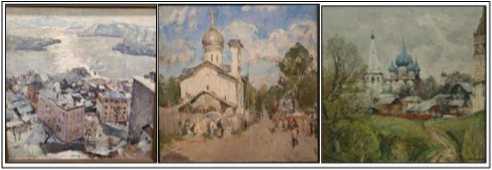
Fig. 1 - Paintings by A. Y. Matyukhin "Silver Bay", "Mon astyrsky courtyard", "Ch urch"
Further in the article, using the example of works by Russian (Far Eastern) and Chinese artists, we will consider the peculiarities of perception of the image of the country / city among the audience (participants of exhibitions, auctions, master classes, biennales, etc. events).
Examining the perception of the image of Vladivostok in the paintings of S.M. Cherkasov, respondents (participants of the exhibition held at the Primorsky State Art Gallery, in the number of 100 people, and Chinese spectators, students studying in Vladivostok, in the number of 34 people, participants of the same exhibition) identified the following image characteristics: the city is historical, special, mysterious and even fabulous. Many viewers refer to such characteristics as: snowy or foggy, as well as good-natured, warm (Chinese viewers noted). Vladivostok residents most often talk about their favorite places and architectural structures that have become historical long ago (Morgorodok, brick buildings with worn walls on Aleutskaya Street, Briner’s house, etc.). In their version, some viewers noted those very old trams, which now only resemble the "passing era", miraculously imprinted on the canvases of the master, and today it is possible to study the history of Vladivostok from the paintings of this artist.
2025 Vol. 19lss. 1
SERVICE plus
SCIENTIFIC JOURNAL
Indeed, the artist's paintings show a careful attitude to the history of his city and depict the image objects of the city, such as, for example, the funicular, which any guest of the city who has ever visited Vladivostok dreams going by, Briner’s house, or to see what the Golden Horn Bay was like before the construction of the bridge.
Fine art has always been the basis of the "memory of the people", its traditions, and its cultural heritage as the perception of a work of art testifies not only about the individual, artistic and figurative originality of the creator, but also characterizes the collective forms of experience peculiar to his time.
Perceiving a work of art, the viewer pays attention to the visible values preserved by history, but the spiritual origins are no less important: the character of the people, their worldview, the type of national thinking, the specifics of the language.
Thus, in Cherkasov's works, one can trace certain traditions peculiar not only to Vladivostok residents, but also to Russians in general. For example, traditional tea drinking, and especially tea made in a samovar on firewood, is a native Russian tradition, which is lovingly painted by the artist... or drinking tea with lemon in a glass with a cup holder is also a kind of designation of tea drinking as a pleasant pastime.

Fig. 2 - Paintings by the artist S. M. Cherkasov "Morgorodok", "Aleutskaya Street", "Svetlanskaya Street"

Fig. 3 - Paintings by the artist S. M. Cherkasov "Funicular", "Briner's House", "The Golden Horn Bay"

Fig. 4 - Paintings by the artist S. M. Cherkasov "Tea on firewood", "Still life painting"
СЕРВИС plus
НАУЧНЫЙ ЖУРНАЛ
2025 Том 19 №1
Thus, based on the culturological approach in analyzing the image of the city, the lifestyle of its inhabitants, we have come to the conclusion that it is the main one from the point of view of the topic under consideration, as it conveys a large amount of information through the prism of system-forming concepts such as culture, cultural patterns, norms, values and lifestyle.
Justifying the use of the symbolic method in this work, which is based on the theory of sign and sign systems, an approach to "language" is important to us a work of art, as a system of signs, the allocation of conventional signs with an unmotivated relationship between the plan of content and the plan of expression and pictorial (iconic) signs with an established system of connections between these plans.
Considering the possibility of using the symbolic method in the study of the image of the city in an image context, the works of I. Obukhov were analyzed in the perception of the audience, participants of the artist's exhibition, both in Russia (in Vladivostok) and in China. The artist’s paintings clearly show an ironic attitude towards his beloved city. The author calls him Vlad or Vladik, as is customary for all Primorye residents. Portraying his hero in a budenovka with a starfish, he symbolizes the image of his beloved city as a young boy, a traveler, a little cocky and very open. In the second painting Vladik is depicted in a cap in the image of a Red Army soldier, in the next painting we see Vlad the imperial. And there is a huge love for his city in all these images, and this attitude is transmitted to the viewer too.
The painting "Star of Primorskaya" shows Vlad as a traveler, he is going on a long journey by rail. There is an inscription "9288 kilometres” on a suitcase that Vlad is holding in his hands. It means a distance from Moscow to Vladivostok. The image of Vlad is easily read by Russian viewers, but remains an interesting mystery for foreign viewers who are the representatives of other cultures.
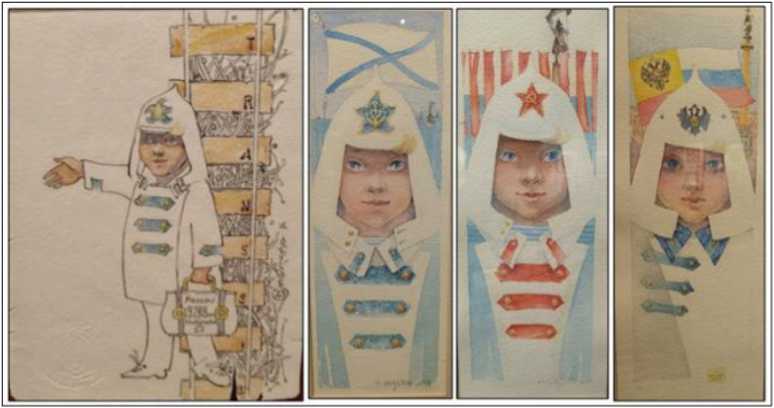
Fig. 5 - Paintings by I. Obukhov "Star of Primorskaya", "Vlad - star of the sea”, "Vlad - Red Army soldier", "Vlad - imperial”
Respondents, exhibition participants in the number of 172 people, highlighting the image the characteristics of Vladivostok noted most often: the city of the sea, our Vladik, the beginning the railway track, their own city, their native one; but the Chinese viewers gave the following characteristics: a revolutionary city, an outpost city in the Far East.
Along with the above-presented studies of the perception of the image of Vladivostok in the works of Primorsky artists, the work presents an analysis of the works of Chinese artists who captured Vladivostok at different times and exhibited their paintings both in Russia and China. When comparing landscape works by Chinese and Russian artists dedicated to the image of Vladivostok, it should be noted that they have both common features and differences.
Thus, in Song Yuming’s paintings made in Chinese style the image of Vladivostok is presented in a dull dark settlement located among low mountains made in black shades which in fact are not visible in the marine bright green city. On the one hand, the artist's paintings depict recognizable objects- a railway station, monuments and other architectural landmarks. On the other hand, low mountains, which the city is surrounded with, are made in a typical Chinese manner, as only Chinese artists do.
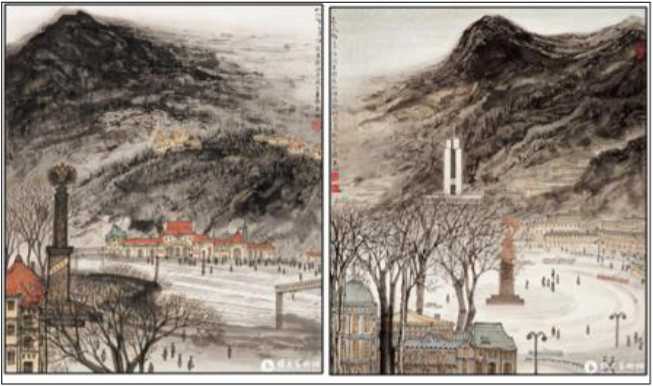
Fig. 6 - Paintings by the artist Song Yuming "Railway station in Vladivostok", "Central Square in Vladivostok'
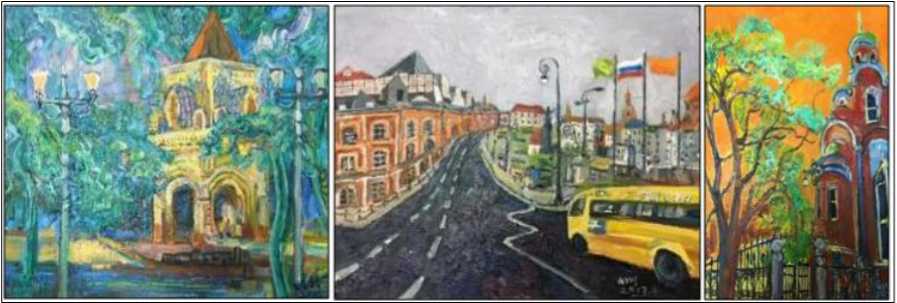
Fig. 7 - Paintings by Wang Yaohua "Park. Vladivostok", "Aleutskaya str. in Vladivostok", "Orthodox Church’’
After analyzing the perception of the image of Vladivostok in the works of Song Yuming, the following image characteristics were identified: Vladivostok is a city on the hills, a traditional, classic, snow-covered and gloomy city, often without the sun. However, there were other statements: a city with a firm character, bright, expressive.
A completely different view of Vladivostok is presented in the paintings of the artist Wang Yaohua, made in the style of Van Gogh. The city is bright, joyful, cheerful, a little fabulous; that is how the artist shows the image of the city in his works.
Respondents and participants of the artist's exhibitions mention the following image characteristics as: a love-soaked, cheerful, lively sea city, a combination of East and West, different cultures in one city, a temple as the basis of life.
A number of Chinese artists who represent the image of Vladivostok in their pictures see it as: bright, sunny, impressive, open and lively. Thus, discussing Reng Guangyue's works the viewers say about Vladivostok as crowded, cohesive, civilized, "The Charm of Asia and the East" an even such an interesting comparison was noted in its version: "it resembles a cool sea breeze." As for the work of the artist Nu Rongyao, respondents highlighted such characteristics as "The lively life of a port city", “the sailors before the leaving for a long cruise”, "meetings and saying good bye in a city by the sea".
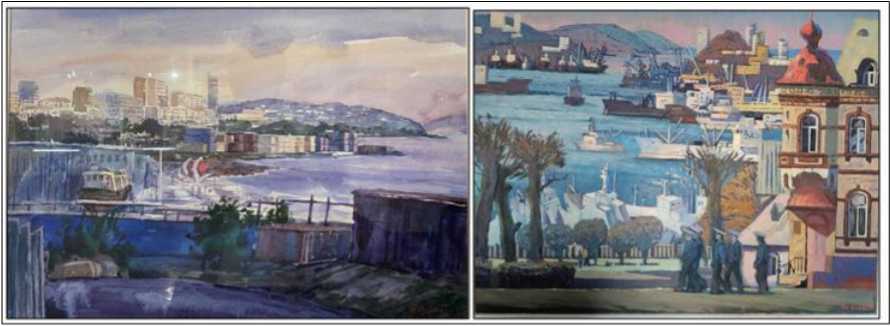
Fig. 8 - Paintings by Reng Guangyue "Vladivostok. The city by the sea", Nu Junyao "In Vladivostok"
Conclusion
So, after conducting a study on the image of the city of Vladivostok, it was revealed that the city as an object, in all its diversity, can be considered from the point of view of a variety of sciences, however, considering the image of the city as a cultural category it is possible to apply an image approach to the study of the image of a particular city, since the focus of artistic culture turns out to be the city's inherent features of originality, uniqueness, its unique look, transformed by the artist in the works he has created. This study highlights the importance of the role of fine art of Chinese and Russian artists in the perception of the image not only of cities as individuals but also a country as a whole in the context of establishing a favorable intercultural dialogue.

